Business Law Report: Contractual Elements, Negligence Impact Analysis
VerifiedAdded on 2020/02/14
|14
|5455
|40
Report
AI Summary
This report delves into the core aspects of contract law and negligence within a business context. It begins by defining contracts as legally enforceable agreements, emphasizing the importance of understanding legal and regulatory proceedings in commercial transactions. The report outlines the essential elements of a valid contract, including offer, acceptance, consideration, capacity, and intention. It then explores the impact of contracts in various situations, such as face-to-face, written, and distance selling scenarios. The report also differentiates between contractual terms like conditions, warranties, and innominate terms, along with the role of exemption clauses. Furthermore, the report analyzes scenarios to determine the validity of contracts and the enforceability of exclusion clauses and implied terms, providing a comprehensive overview of contract and negligence principles in business operations.
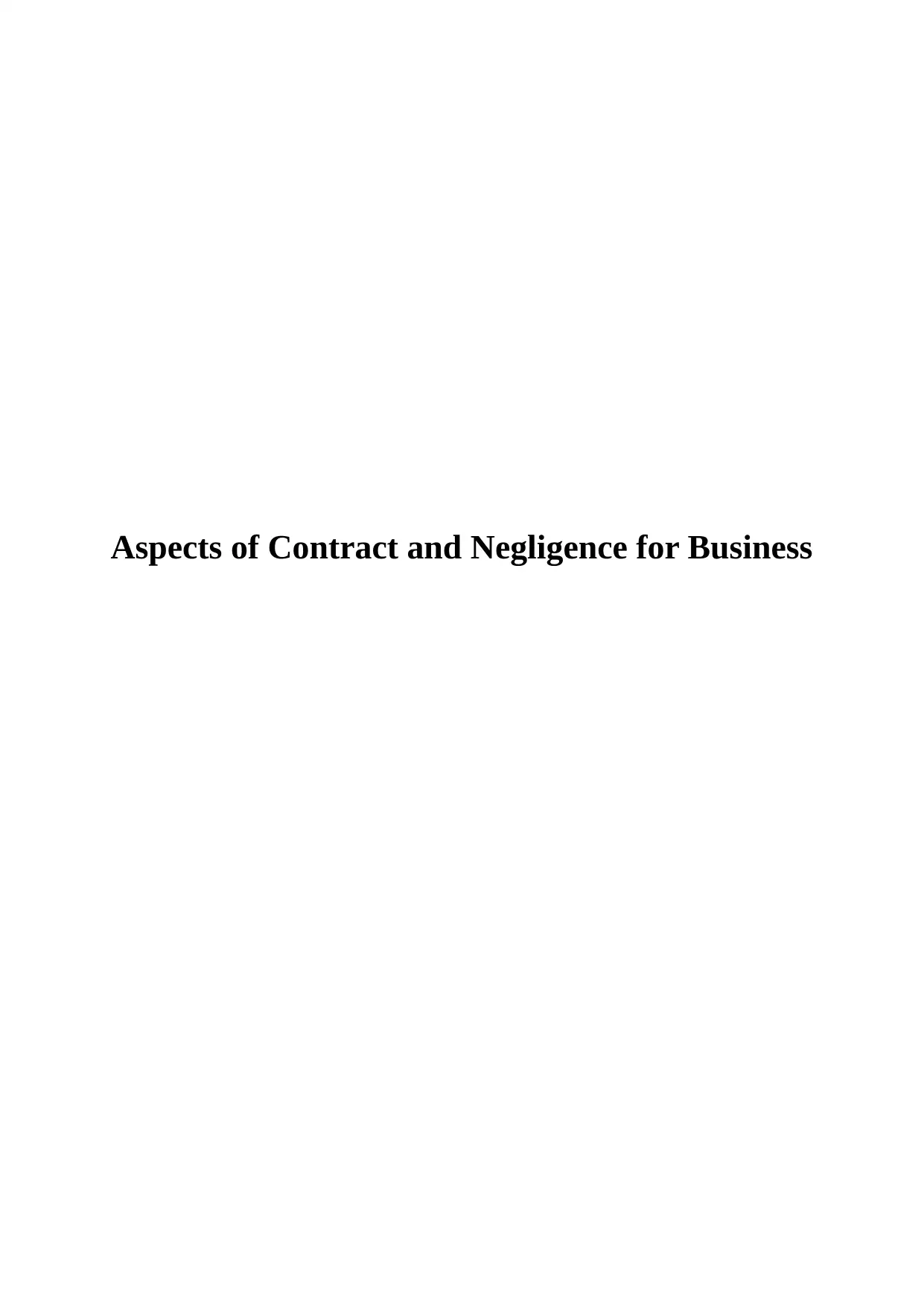
Aspects of Contract and Negligence for Business
Paraphrase This Document
Need a fresh take? Get an instant paraphrase of this document with our AI Paraphraser
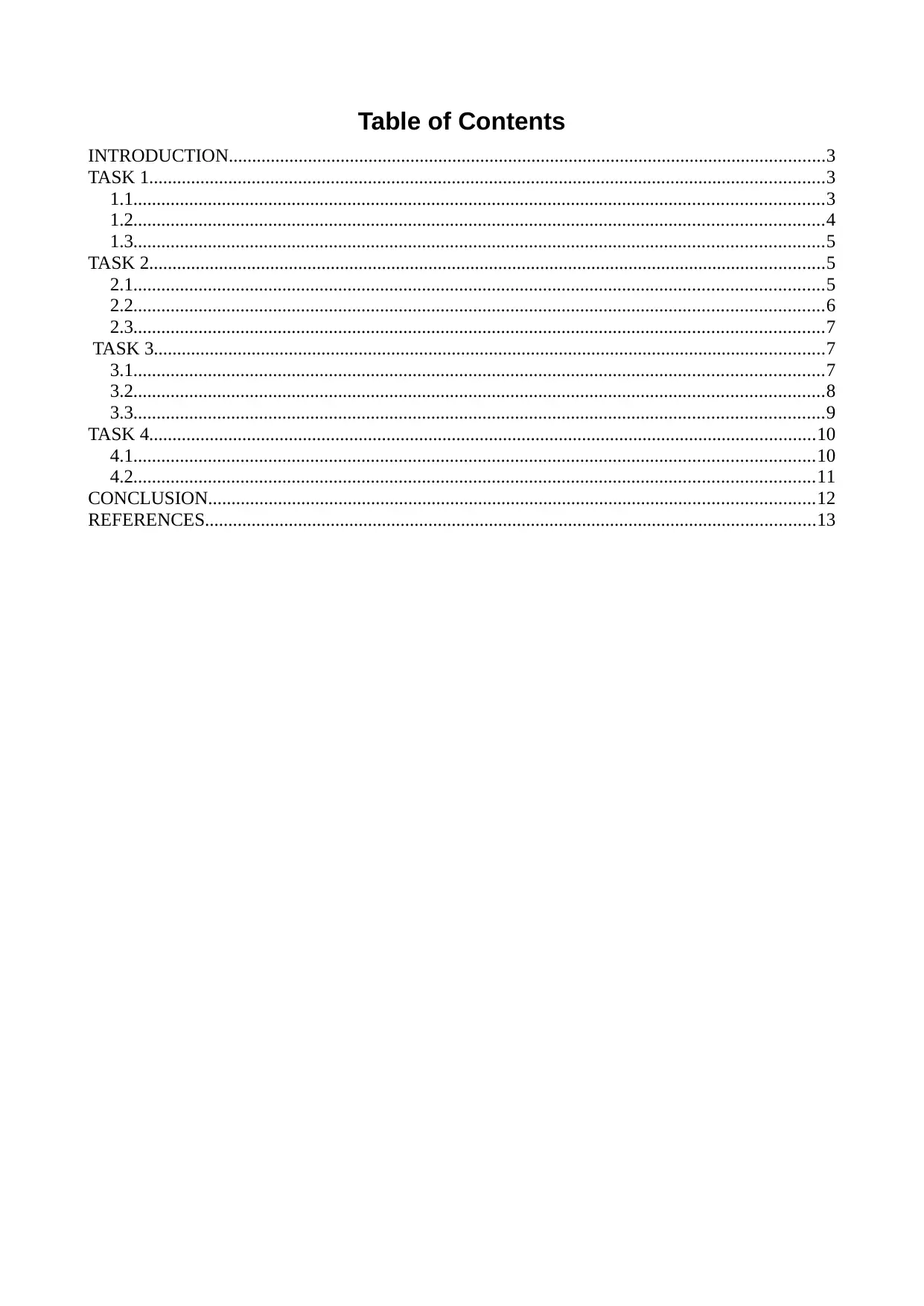
Table of Contents
INTRODUCTION................................................................................................................................3
TASK 1.................................................................................................................................................3
1.1....................................................................................................................................................3
1.2....................................................................................................................................................4
1.3....................................................................................................................................................5
TASK 2.................................................................................................................................................5
2.1....................................................................................................................................................5
2.2....................................................................................................................................................6
2.3....................................................................................................................................................7
TASK 3................................................................................................................................................7
3.1....................................................................................................................................................7
3.2....................................................................................................................................................8
3.3....................................................................................................................................................9
TASK 4...............................................................................................................................................10
4.1..................................................................................................................................................10
4.2..................................................................................................................................................11
CONCLUSION..................................................................................................................................12
REFERENCES...................................................................................................................................13
INTRODUCTION................................................................................................................................3
TASK 1.................................................................................................................................................3
1.1....................................................................................................................................................3
1.2....................................................................................................................................................4
1.3....................................................................................................................................................5
TASK 2.................................................................................................................................................5
2.1....................................................................................................................................................5
2.2....................................................................................................................................................6
2.3....................................................................................................................................................7
TASK 3................................................................................................................................................7
3.1....................................................................................................................................................7
3.2....................................................................................................................................................8
3.3....................................................................................................................................................9
TASK 4...............................................................................................................................................10
4.1..................................................................................................................................................10
4.2..................................................................................................................................................11
CONCLUSION..................................................................................................................................12
REFERENCES...................................................................................................................................13

INTRODUCTION
Contrcats are those agreemnts which are leagllu enforceable by the law, and are binding on
all the parties of the settlement. In today's era it has become need of the time to understand all the
legal and regulatory proceedings which are prominently trequird to carry the commercial
transactions (Christian and Campbell, 2009). Negligence and contract both terms are considered the
most importnat part of legislation. In the present report all the essential elemnts of a contract are
defined. Along with this the impact of these terms on the business and individulas are also to be
highlighted in the study. The study is based on the scenerios and case studies which are having a
deep focus on the application of various elemnts of an agreemnet.
TASK 1
1.1
The contract is an agreement which is made between the parties and is enforceable by law. It
binds both parties with a contract. The court enforce the settlements until there are grounds that
resist its legal validity. Peter Abraham has the intention to start a business of building contractor and
for him it is essential to understand all those terms which are essentially required to make valid
contract. There are some basic features which must be present in a valid agreement these are as
under:
Offer: This the most prime part which is essential to make a covenant. It shows the readiness
of a party for making an agreement, which is accepted by another party. It is applicable for a
reasonable duration until another party shows the intention of revoke that particular
settlement. Along with this it is also a major part to be considered that silence cannot be
regarded as acceptance in a offer (Campbell, 2013).
Acceptance: There cannot be a contract until the offer is accepted by another party. And the
acceptance can be made orally or in writing. Thus this element shows that both parties
should be agree for making a contract. In it the another point is that if the person to whom
the offer is made gets agree on some terms and has some new terms then it would not be
regarded as an agreement as both the parties must agree on common terms of the covenant.
Consideration: It refers a detriment to the person who has made the promise or a benofit
conferred to another party. The consideration can be measurable in economic terms. It can
be money, goods and services. Another point which is to be noted that the consideration
need not be adequate (Pozgar, 2011).
Capacity: It is another major element for making an agreement. As both the parties should
Contrcats are those agreemnts which are leagllu enforceable by the law, and are binding on
all the parties of the settlement. In today's era it has become need of the time to understand all the
legal and regulatory proceedings which are prominently trequird to carry the commercial
transactions (Christian and Campbell, 2009). Negligence and contract both terms are considered the
most importnat part of legislation. In the present report all the essential elemnts of a contract are
defined. Along with this the impact of these terms on the business and individulas are also to be
highlighted in the study. The study is based on the scenerios and case studies which are having a
deep focus on the application of various elemnts of an agreemnet.
TASK 1
1.1
The contract is an agreement which is made between the parties and is enforceable by law. It
binds both parties with a contract. The court enforce the settlements until there are grounds that
resist its legal validity. Peter Abraham has the intention to start a business of building contractor and
for him it is essential to understand all those terms which are essentially required to make valid
contract. There are some basic features which must be present in a valid agreement these are as
under:
Offer: This the most prime part which is essential to make a covenant. It shows the readiness
of a party for making an agreement, which is accepted by another party. It is applicable for a
reasonable duration until another party shows the intention of revoke that particular
settlement. Along with this it is also a major part to be considered that silence cannot be
regarded as acceptance in a offer (Campbell, 2013).
Acceptance: There cannot be a contract until the offer is accepted by another party. And the
acceptance can be made orally or in writing. Thus this element shows that both parties
should be agree for making a contract. In it the another point is that if the person to whom
the offer is made gets agree on some terms and has some new terms then it would not be
regarded as an agreement as both the parties must agree on common terms of the covenant.
Consideration: It refers a detriment to the person who has made the promise or a benofit
conferred to another party. The consideration can be measurable in economic terms. It can
be money, goods and services. Another point which is to be noted that the consideration
need not be adequate (Pozgar, 2011).
Capacity: It is another major element for making an agreement. As both the parties should
⊘ This is a preview!⊘
Do you want full access?
Subscribe today to unlock all pages.

Trusted by 1+ million students worldwide

be capable for making the contract. As per the law the person who is below the age of 18 is
not liable to make the settlement. In the same manner if the person is lacking legal capacity
of making an agreement is not capable to create a contract. Thus for making a covenant it is
very important to have the capacity of making it.
Intention to make the contract: It is a common thing of concern that if the commercial
transactions are being made then both the parties of the agreement must have the intention to
create it. This can be rejected only in that case where any of the party of the covenant has
expressly showed that they are not intended to make the contract. Thus for making a valid
agreement it is important for both the parties to have the intention of making that particular
contract (Sweet and Schneier, 2012).
Thus in above mentioned way all the essential elements of making a valid contract have
been discussed.
1.2
Impact of contract in various situations is described as under:
Face to face Contract: As per the given scenario if Peter Abraham has plan to make face to
face agreements then it can be treated as expressed terms of contracts. In the elements are
specifically stated such as there are offer, acceptance and consideration. Further Peter
Abraham has a plan to become a building contractor and for this it is required to get entered
into the contracts with the parties. In it there can be terms on which the parties can be ready
such as age and mental capacity to enter into the settlement. Thus in face to face contracts it
is essential to make the agreements by analysing all the essential factors to make the
contract and it would be regarded as legal contracts (Dimond, 2009).
Written Contracts: The impact of these contracts are much valid than the others. It is the
completely legal contract. Peter Abraham can make the agreement in writing as for the
contractor business, it is essential to make the settlement in written format. As these
contracts are much legally valid then the others.
Distance Selling: This kind of contracts are having least effectiveness as these sort of
agreements are usually made on telephone and through internet measures. It is not regarded
as legal term and for making a valid contract it is essential to have all the factors of a valid
agreement. Such as offer, acceptance, consideration, lawful object and capacity to make a
covenant. Thus these all aspects should be there while making distance selling transactions
or agreements (Sanchez-Lorenzo, 2013).
not liable to make the settlement. In the same manner if the person is lacking legal capacity
of making an agreement is not capable to create a contract. Thus for making a covenant it is
very important to have the capacity of making it.
Intention to make the contract: It is a common thing of concern that if the commercial
transactions are being made then both the parties of the agreement must have the intention to
create it. This can be rejected only in that case where any of the party of the covenant has
expressly showed that they are not intended to make the contract. Thus for making a valid
agreement it is important for both the parties to have the intention of making that particular
contract (Sweet and Schneier, 2012).
Thus in above mentioned way all the essential elements of making a valid contract have
been discussed.
1.2
Impact of contract in various situations is described as under:
Face to face Contract: As per the given scenario if Peter Abraham has plan to make face to
face agreements then it can be treated as expressed terms of contracts. In the elements are
specifically stated such as there are offer, acceptance and consideration. Further Peter
Abraham has a plan to become a building contractor and for this it is required to get entered
into the contracts with the parties. In it there can be terms on which the parties can be ready
such as age and mental capacity to enter into the settlement. Thus in face to face contracts it
is essential to make the agreements by analysing all the essential factors to make the
contract and it would be regarded as legal contracts (Dimond, 2009).
Written Contracts: The impact of these contracts are much valid than the others. It is the
completely legal contract. Peter Abraham can make the agreement in writing as for the
contractor business, it is essential to make the settlement in written format. As these
contracts are much legally valid then the others.
Distance Selling: This kind of contracts are having least effectiveness as these sort of
agreements are usually made on telephone and through internet measures. It is not regarded
as legal term and for making a valid contract it is essential to have all the factors of a valid
agreement. Such as offer, acceptance, consideration, lawful object and capacity to make a
covenant. Thus these all aspects should be there while making distance selling transactions
or agreements (Sanchez-Lorenzo, 2013).
Paraphrase This Document
Need a fresh take? Get an instant paraphrase of this document with our AI Paraphraser
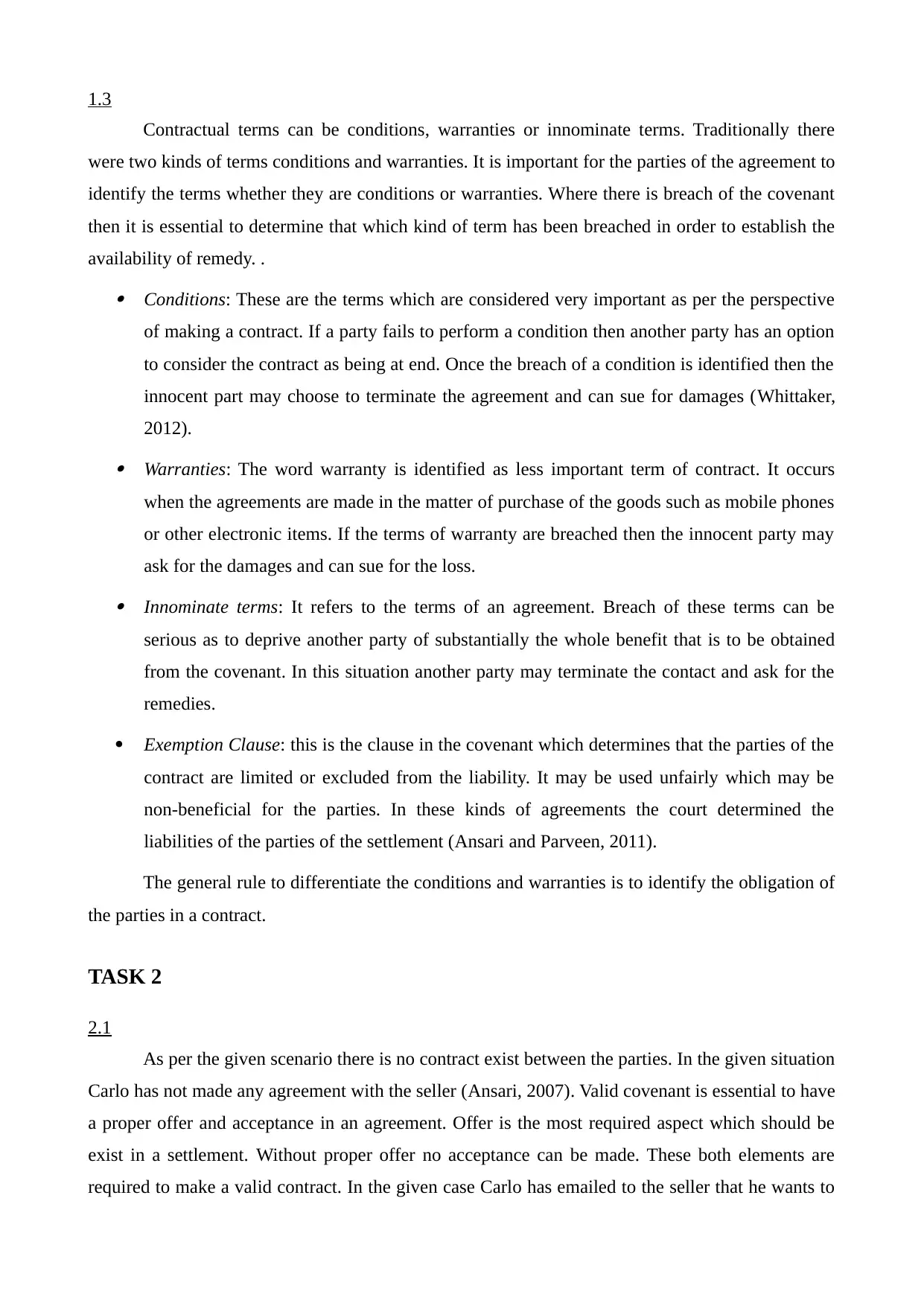
1.3
Contractual terms can be conditions, warranties or innominate terms. Traditionally there
were two kinds of terms conditions and warranties. It is important for the parties of the agreement to
identify the terms whether they are conditions or warranties. Where there is breach of the covenant
then it is essential to determine that which kind of term has been breached in order to establish the
availability of remedy. .
Conditions: These are the terms which are considered very important as per the perspective
of making a contract. If a party fails to perform a condition then another party has an option
to consider the contract as being at end. Once the breach of a condition is identified then the
innocent part may choose to terminate the agreement and can sue for damages (Whittaker,
2012).
Warranties: The word warranty is identified as less important term of contract. It occurs
when the agreements are made in the matter of purchase of the goods such as mobile phones
or other electronic items. If the terms of warranty are breached then the innocent party may
ask for the damages and can sue for the loss.
Innominate terms: It refers to the terms of an agreement. Breach of these terms can be
serious as to deprive another party of substantially the whole benefit that is to be obtained
from the covenant. In this situation another party may terminate the contact and ask for the
remedies.
Exemption Clause: this is the clause in the covenant which determines that the parties of the
contract are limited or excluded from the liability. It may be used unfairly which may be
non-beneficial for the parties. In these kinds of agreements the court determined the
liabilities of the parties of the settlement (Ansari and Parveen, 2011).
The general rule to differentiate the conditions and warranties is to identify the obligation of
the parties in a contract.
TASK 2
2.1
As per the given scenario there is no contract exist between the parties. In the given situation
Carlo has not made any agreement with the seller (Ansari, 2007). Valid covenant is essential to have
a proper offer and acceptance in an agreement. Offer is the most required aspect which should be
exist in a settlement. Without proper offer no acceptance can be made. These both elements are
required to make a valid contract. In the given case Carlo has emailed to the seller that he wants to
Contractual terms can be conditions, warranties or innominate terms. Traditionally there
were two kinds of terms conditions and warranties. It is important for the parties of the agreement to
identify the terms whether they are conditions or warranties. Where there is breach of the covenant
then it is essential to determine that which kind of term has been breached in order to establish the
availability of remedy. .
Conditions: These are the terms which are considered very important as per the perspective
of making a contract. If a party fails to perform a condition then another party has an option
to consider the contract as being at end. Once the breach of a condition is identified then the
innocent part may choose to terminate the agreement and can sue for damages (Whittaker,
2012).
Warranties: The word warranty is identified as less important term of contract. It occurs
when the agreements are made in the matter of purchase of the goods such as mobile phones
or other electronic items. If the terms of warranty are breached then the innocent party may
ask for the damages and can sue for the loss.
Innominate terms: It refers to the terms of an agreement. Breach of these terms can be
serious as to deprive another party of substantially the whole benefit that is to be obtained
from the covenant. In this situation another party may terminate the contact and ask for the
remedies.
Exemption Clause: this is the clause in the covenant which determines that the parties of the
contract are limited or excluded from the liability. It may be used unfairly which may be
non-beneficial for the parties. In these kinds of agreements the court determined the
liabilities of the parties of the settlement (Ansari and Parveen, 2011).
The general rule to differentiate the conditions and warranties is to identify the obligation of
the parties in a contract.
TASK 2
2.1
As per the given scenario there is no contract exist between the parties. In the given situation
Carlo has not made any agreement with the seller (Ansari, 2007). Valid covenant is essential to have
a proper offer and acceptance in an agreement. Offer is the most required aspect which should be
exist in a settlement. Without proper offer no acceptance can be made. These both elements are
required to make a valid contract. In the given case Carlo has emailed to the seller that he wants to
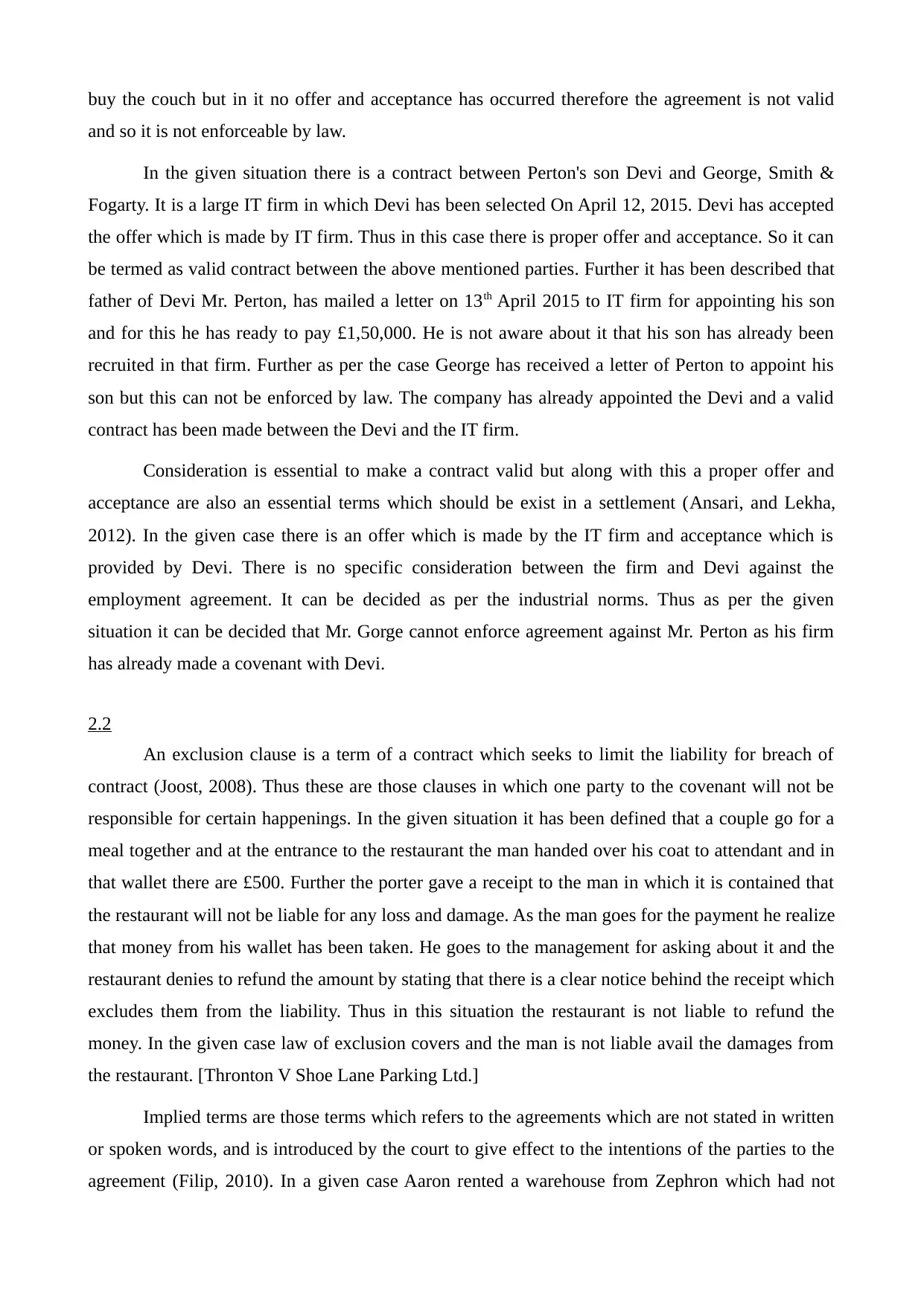
buy the couch but in it no offer and acceptance has occurred therefore the agreement is not valid
and so it is not enforceable by law.
In the given situation there is a contract between Perton's son Devi and George, Smith &
Fogarty. It is a large IT firm in which Devi has been selected On April 12, 2015. Devi has accepted
the offer which is made by IT firm. Thus in this case there is proper offer and acceptance. So it can
be termed as valid contract between the above mentioned parties. Further it has been described that
father of Devi Mr. Perton, has mailed a letter on 13th April 2015 to IT firm for appointing his son
and for this he has ready to pay £1,50,000. He is not aware about it that his son has already been
recruited in that firm. Further as per the case George has received a letter of Perton to appoint his
son but this can not be enforced by law. The company has already appointed the Devi and a valid
contract has been made between the Devi and the IT firm.
Consideration is essential to make a contract valid but along with this a proper offer and
acceptance are also an essential terms which should be exist in a settlement (Ansari, and Lekha,
2012). In the given case there is an offer which is made by the IT firm and acceptance which is
provided by Devi. There is no specific consideration between the firm and Devi against the
employment agreement. It can be decided as per the industrial norms. Thus as per the given
situation it can be decided that Mr. Gorge cannot enforce agreement against Mr. Perton as his firm
has already made a covenant with Devi.
2.2
An exclusion clause is a term of a contract which seeks to limit the liability for breach of
contract (Joost, 2008). Thus these are those clauses in which one party to the covenant will not be
responsible for certain happenings. In the given situation it has been defined that a couple go for a
meal together and at the entrance to the restaurant the man handed over his coat to attendant and in
that wallet there are £500. Further the porter gave a receipt to the man in which it is contained that
the restaurant will not be liable for any loss and damage. As the man goes for the payment he realize
that money from his wallet has been taken. He goes to the management for asking about it and the
restaurant denies to refund the amount by stating that there is a clear notice behind the receipt which
excludes them from the liability. Thus in this situation the restaurant is not liable to refund the
money. In the given case law of exclusion covers and the man is not liable avail the damages from
the restaurant. [Thronton V Shoe Lane Parking Ltd.]
Implied terms are those terms which refers to the agreements which are not stated in written
or spoken words, and is introduced by the court to give effect to the intentions of the parties to the
agreement (Filip, 2010). In a given case Aaron rented a warehouse from Zephron which had not
and so it is not enforceable by law.
In the given situation there is a contract between Perton's son Devi and George, Smith &
Fogarty. It is a large IT firm in which Devi has been selected On April 12, 2015. Devi has accepted
the offer which is made by IT firm. Thus in this case there is proper offer and acceptance. So it can
be termed as valid contract between the above mentioned parties. Further it has been described that
father of Devi Mr. Perton, has mailed a letter on 13th April 2015 to IT firm for appointing his son
and for this he has ready to pay £1,50,000. He is not aware about it that his son has already been
recruited in that firm. Further as per the case George has received a letter of Perton to appoint his
son but this can not be enforced by law. The company has already appointed the Devi and a valid
contract has been made between the Devi and the IT firm.
Consideration is essential to make a contract valid but along with this a proper offer and
acceptance are also an essential terms which should be exist in a settlement (Ansari, and Lekha,
2012). In the given case there is an offer which is made by the IT firm and acceptance which is
provided by Devi. There is no specific consideration between the firm and Devi against the
employment agreement. It can be decided as per the industrial norms. Thus as per the given
situation it can be decided that Mr. Gorge cannot enforce agreement against Mr. Perton as his firm
has already made a covenant with Devi.
2.2
An exclusion clause is a term of a contract which seeks to limit the liability for breach of
contract (Joost, 2008). Thus these are those clauses in which one party to the covenant will not be
responsible for certain happenings. In the given situation it has been defined that a couple go for a
meal together and at the entrance to the restaurant the man handed over his coat to attendant and in
that wallet there are £500. Further the porter gave a receipt to the man in which it is contained that
the restaurant will not be liable for any loss and damage. As the man goes for the payment he realize
that money from his wallet has been taken. He goes to the management for asking about it and the
restaurant denies to refund the amount by stating that there is a clear notice behind the receipt which
excludes them from the liability. Thus in this situation the restaurant is not liable to refund the
money. In the given case law of exclusion covers and the man is not liable avail the damages from
the restaurant. [Thronton V Shoe Lane Parking Ltd.]
Implied terms are those terms which refers to the agreements which are not stated in written
or spoken words, and is introduced by the court to give effect to the intentions of the parties to the
agreement (Filip, 2010). In a given case Aaron rented a warehouse from Zephron which had not
⊘ This is a preview!⊘
Do you want full access?
Subscribe today to unlock all pages.

Trusted by 1+ million students worldwide
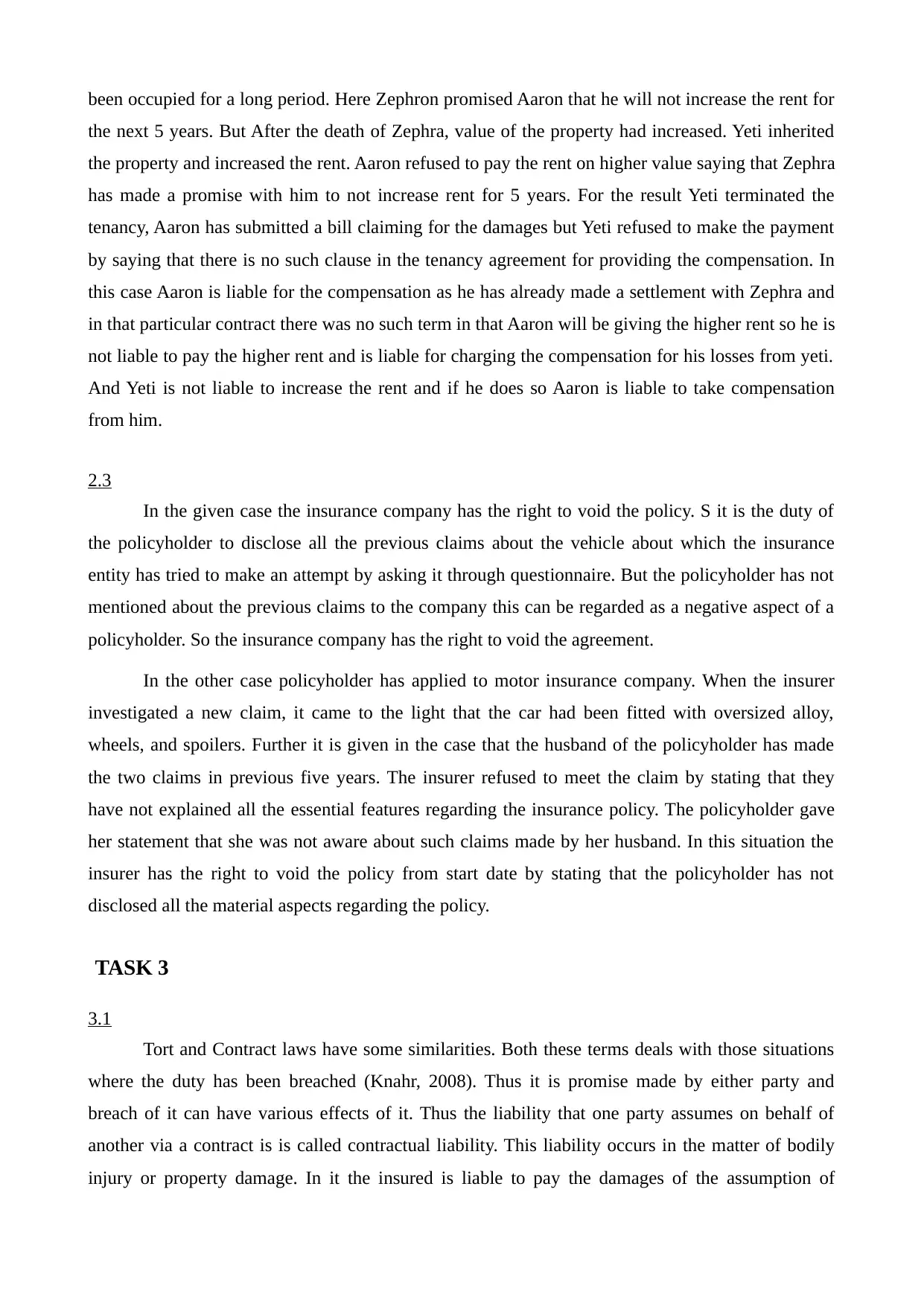
been occupied for a long period. Here Zephron promised Aaron that he will not increase the rent for
the next 5 years. But After the death of Zephra, value of the property had increased. Yeti inherited
the property and increased the rent. Aaron refused to pay the rent on higher value saying that Zephra
has made a promise with him to not increase rent for 5 years. For the result Yeti terminated the
tenancy, Aaron has submitted a bill claiming for the damages but Yeti refused to make the payment
by saying that there is no such clause in the tenancy agreement for providing the compensation. In
this case Aaron is liable for the compensation as he has already made a settlement with Zephra and
in that particular contract there was no such term in that Aaron will be giving the higher rent so he is
not liable to pay the higher rent and is liable for charging the compensation for his losses from yeti.
And Yeti is not liable to increase the rent and if he does so Aaron is liable to take compensation
from him.
2.3
In the given case the insurance company has the right to void the policy. S it is the duty of
the policyholder to disclose all the previous claims about the vehicle about which the insurance
entity has tried to make an attempt by asking it through questionnaire. But the policyholder has not
mentioned about the previous claims to the company this can be regarded as a negative aspect of a
policyholder. So the insurance company has the right to void the agreement.
In the other case policyholder has applied to motor insurance company. When the insurer
investigated a new claim, it came to the light that the car had been fitted with oversized alloy,
wheels, and spoilers. Further it is given in the case that the husband of the policyholder has made
the two claims in previous five years. The insurer refused to meet the claim by stating that they
have not explained all the essential features regarding the insurance policy. The policyholder gave
her statement that she was not aware about such claims made by her husband. In this situation the
insurer has the right to void the policy from start date by stating that the policyholder has not
disclosed all the material aspects regarding the policy.
TASK 3
3.1
Tort and Contract laws have some similarities. Both these terms deals with those situations
where the duty has been breached (Knahr, 2008). Thus it is promise made by either party and
breach of it can have various effects of it. Thus the liability that one party assumes on behalf of
another via a contract is is called contractual liability. This liability occurs in the matter of bodily
injury or property damage. In it the insured is liable to pay the damages of the assumption of
the next 5 years. But After the death of Zephra, value of the property had increased. Yeti inherited
the property and increased the rent. Aaron refused to pay the rent on higher value saying that Zephra
has made a promise with him to not increase rent for 5 years. For the result Yeti terminated the
tenancy, Aaron has submitted a bill claiming for the damages but Yeti refused to make the payment
by saying that there is no such clause in the tenancy agreement for providing the compensation. In
this case Aaron is liable for the compensation as he has already made a settlement with Zephra and
in that particular contract there was no such term in that Aaron will be giving the higher rent so he is
not liable to pay the higher rent and is liable for charging the compensation for his losses from yeti.
And Yeti is not liable to increase the rent and if he does so Aaron is liable to take compensation
from him.
2.3
In the given case the insurance company has the right to void the policy. S it is the duty of
the policyholder to disclose all the previous claims about the vehicle about which the insurance
entity has tried to make an attempt by asking it through questionnaire. But the policyholder has not
mentioned about the previous claims to the company this can be regarded as a negative aspect of a
policyholder. So the insurance company has the right to void the agreement.
In the other case policyholder has applied to motor insurance company. When the insurer
investigated a new claim, it came to the light that the car had been fitted with oversized alloy,
wheels, and spoilers. Further it is given in the case that the husband of the policyholder has made
the two claims in previous five years. The insurer refused to meet the claim by stating that they
have not explained all the essential features regarding the insurance policy. The policyholder gave
her statement that she was not aware about such claims made by her husband. In this situation the
insurer has the right to void the policy from start date by stating that the policyholder has not
disclosed all the material aspects regarding the policy.
TASK 3
3.1
Tort and Contract laws have some similarities. Both these terms deals with those situations
where the duty has been breached (Knahr, 2008). Thus it is promise made by either party and
breach of it can have various effects of it. Thus the liability that one party assumes on behalf of
another via a contract is is called contractual liability. This liability occurs in the matter of bodily
injury or property damage. In it the insured is liable to pay the damages of the assumption of
Paraphrase This Document
Need a fresh take? Get an instant paraphrase of this document with our AI Paraphraser
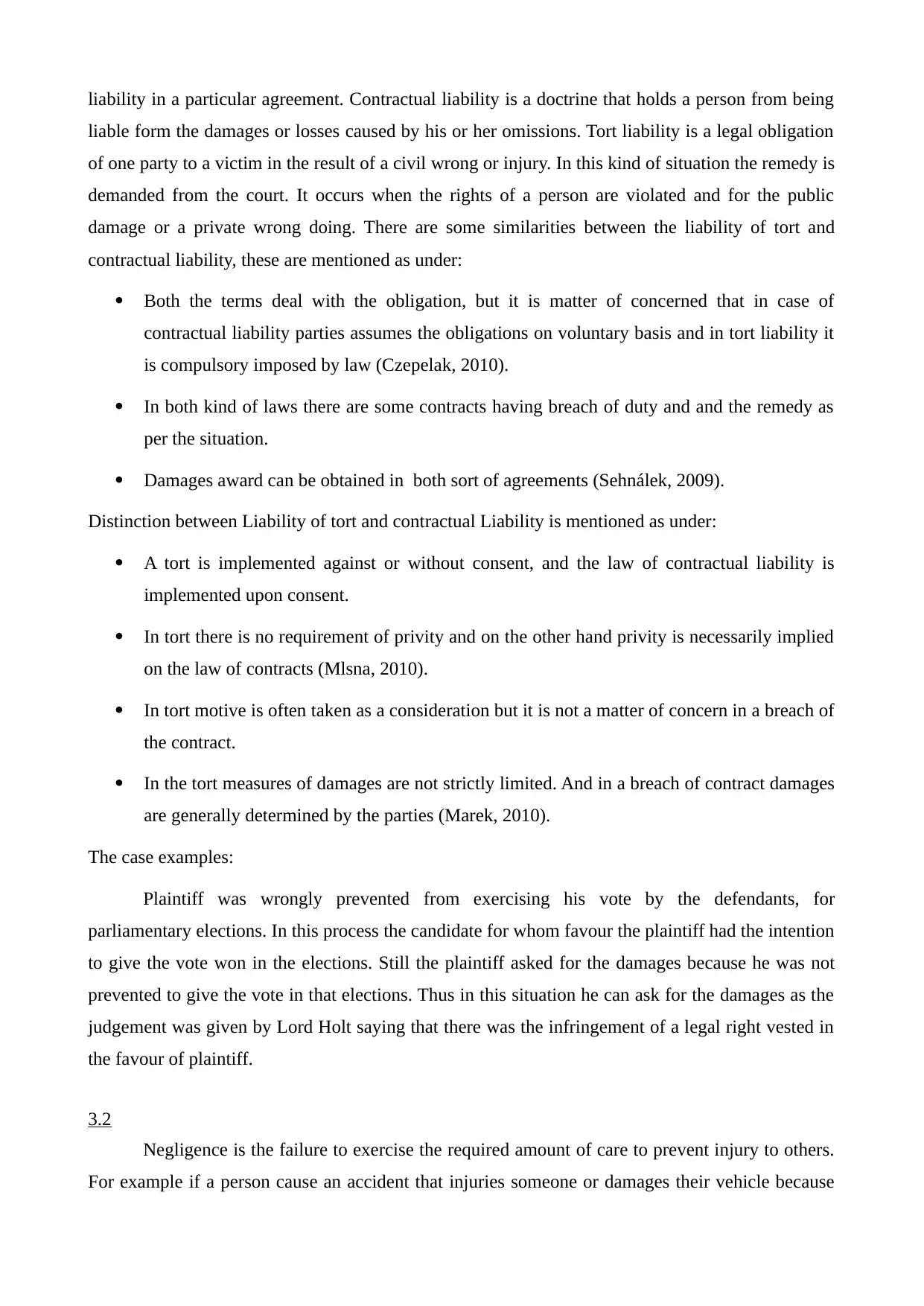
liability in a particular agreement. Contractual liability is a doctrine that holds a person from being
liable form the damages or losses caused by his or her omissions. Tort liability is a legal obligation
of one party to a victim in the result of a civil wrong or injury. In this kind of situation the remedy is
demanded from the court. It occurs when the rights of a person are violated and for the public
damage or a private wrong doing. There are some similarities between the liability of tort and
contractual liability, these are mentioned as under:
Both the terms deal with the obligation, but it is matter of concerned that in case of
contractual liability parties assumes the obligations on voluntary basis and in tort liability it
is compulsory imposed by law (Czepelak, 2010).
In both kind of laws there are some contracts having breach of duty and and the remedy as
per the situation.
Damages award can be obtained in both sort of agreements (Sehnálek, 2009).
Distinction between Liability of tort and contractual Liability is mentioned as under:
A tort is implemented against or without consent, and the law of contractual liability is
implemented upon consent.
In tort there is no requirement of privity and on the other hand privity is necessarily implied
on the law of contracts (Mlsna, 2010).
In tort motive is often taken as a consideration but it is not a matter of concern in a breach of
the contract.
In the tort measures of damages are not strictly limited. And in a breach of contract damages
are generally determined by the parties (Marek, 2010).
The case examples:
Plaintiff was wrongly prevented from exercising his vote by the defendants, for
parliamentary elections. In this process the candidate for whom favour the plaintiff had the intention
to give the vote won in the elections. Still the plaintiff asked for the damages because he was not
prevented to give the vote in that elections. Thus in this situation he can ask for the damages as the
judgement was given by Lord Holt saying that there was the infringement of a legal right vested in
the favour of plaintiff.
3.2
Negligence is the failure to exercise the required amount of care to prevent injury to others.
For example if a person cause an accident that injuries someone or damages their vehicle because
liable form the damages or losses caused by his or her omissions. Tort liability is a legal obligation
of one party to a victim in the result of a civil wrong or injury. In this kind of situation the remedy is
demanded from the court. It occurs when the rights of a person are violated and for the public
damage or a private wrong doing. There are some similarities between the liability of tort and
contractual liability, these are mentioned as under:
Both the terms deal with the obligation, but it is matter of concerned that in case of
contractual liability parties assumes the obligations on voluntary basis and in tort liability it
is compulsory imposed by law (Czepelak, 2010).
In both kind of laws there are some contracts having breach of duty and and the remedy as
per the situation.
Damages award can be obtained in both sort of agreements (Sehnálek, 2009).
Distinction between Liability of tort and contractual Liability is mentioned as under:
A tort is implemented against or without consent, and the law of contractual liability is
implemented upon consent.
In tort there is no requirement of privity and on the other hand privity is necessarily implied
on the law of contracts (Mlsna, 2010).
In tort motive is often taken as a consideration but it is not a matter of concern in a breach of
the contract.
In the tort measures of damages are not strictly limited. And in a breach of contract damages
are generally determined by the parties (Marek, 2010).
The case examples:
Plaintiff was wrongly prevented from exercising his vote by the defendants, for
parliamentary elections. In this process the candidate for whom favour the plaintiff had the intention
to give the vote won in the elections. Still the plaintiff asked for the damages because he was not
prevented to give the vote in that elections. Thus in this situation he can ask for the damages as the
judgement was given by Lord Holt saying that there was the infringement of a legal right vested in
the favour of plaintiff.
3.2
Negligence is the failure to exercise the required amount of care to prevent injury to others.
For example if a person cause an accident that injuries someone or damages their vehicle because
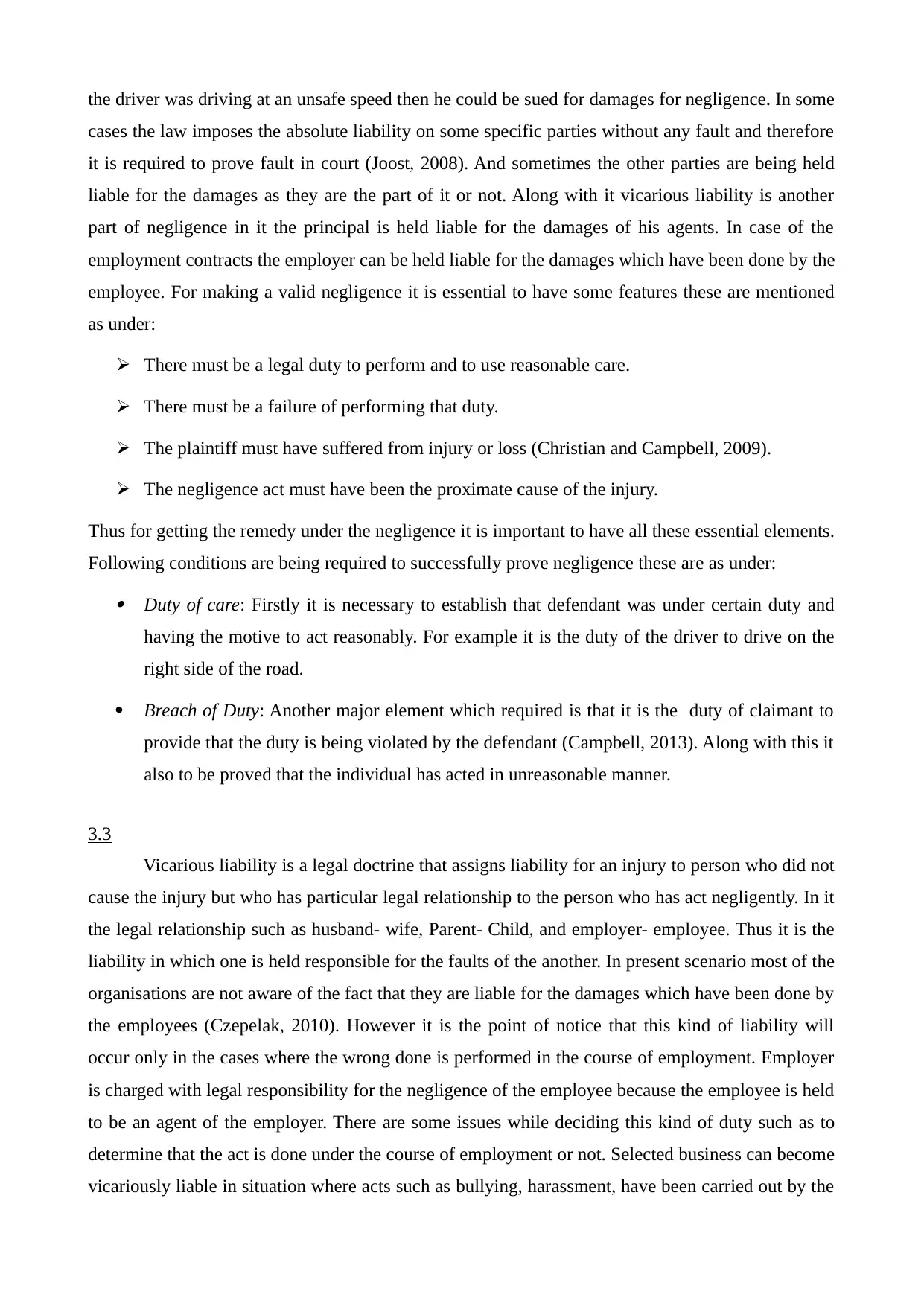
the driver was driving at an unsafe speed then he could be sued for damages for negligence. In some
cases the law imposes the absolute liability on some specific parties without any fault and therefore
it is required to prove fault in court (Joost, 2008). And sometimes the other parties are being held
liable for the damages as they are the part of it or not. Along with it vicarious liability is another
part of negligence in it the principal is held liable for the damages of his agents. In case of the
employment contracts the employer can be held liable for the damages which have been done by the
employee. For making a valid negligence it is essential to have some features these are mentioned
as under:
There must be a legal duty to perform and to use reasonable care.
There must be a failure of performing that duty.
The plaintiff must have suffered from injury or loss (Christian and Campbell, 2009).
The negligence act must have been the proximate cause of the injury.
Thus for getting the remedy under the negligence it is important to have all these essential elements.
Following conditions are being required to successfully prove negligence these are as under:
Duty of care: Firstly it is necessary to establish that defendant was under certain duty and
having the motive to act reasonably. For example it is the duty of the driver to drive on the
right side of the road.
Breach of Duty: Another major element which required is that it is the duty of claimant to
provide that the duty is being violated by the defendant (Campbell, 2013). Along with this it
also to be proved that the individual has acted in unreasonable manner.
3.3
Vicarious liability is a legal doctrine that assigns liability for an injury to person who did not
cause the injury but who has particular legal relationship to the person who has act negligently. In it
the legal relationship such as husband- wife, Parent- Child, and employer- employee. Thus it is the
liability in which one is held responsible for the faults of the another. In present scenario most of the
organisations are not aware of the fact that they are liable for the damages which have been done by
the employees (Czepelak, 2010). However it is the point of notice that this kind of liability will
occur only in the cases where the wrong done is performed in the course of employment. Employer
is charged with legal responsibility for the negligence of the employee because the employee is held
to be an agent of the employer. There are some issues while deciding this kind of duty such as to
determine that the act is done under the course of employment or not. Selected business can become
vicariously liable in situation where acts such as bullying, harassment, have been carried out by the
cases the law imposes the absolute liability on some specific parties without any fault and therefore
it is required to prove fault in court (Joost, 2008). And sometimes the other parties are being held
liable for the damages as they are the part of it or not. Along with it vicarious liability is another
part of negligence in it the principal is held liable for the damages of his agents. In case of the
employment contracts the employer can be held liable for the damages which have been done by the
employee. For making a valid negligence it is essential to have some features these are mentioned
as under:
There must be a legal duty to perform and to use reasonable care.
There must be a failure of performing that duty.
The plaintiff must have suffered from injury or loss (Christian and Campbell, 2009).
The negligence act must have been the proximate cause of the injury.
Thus for getting the remedy under the negligence it is important to have all these essential elements.
Following conditions are being required to successfully prove negligence these are as under:
Duty of care: Firstly it is necessary to establish that defendant was under certain duty and
having the motive to act reasonably. For example it is the duty of the driver to drive on the
right side of the road.
Breach of Duty: Another major element which required is that it is the duty of claimant to
provide that the duty is being violated by the defendant (Campbell, 2013). Along with this it
also to be proved that the individual has acted in unreasonable manner.
3.3
Vicarious liability is a legal doctrine that assigns liability for an injury to person who did not
cause the injury but who has particular legal relationship to the person who has act negligently. In it
the legal relationship such as husband- wife, Parent- Child, and employer- employee. Thus it is the
liability in which one is held responsible for the faults of the another. In present scenario most of the
organisations are not aware of the fact that they are liable for the damages which have been done by
the employees (Czepelak, 2010). However it is the point of notice that this kind of liability will
occur only in the cases where the wrong done is performed in the course of employment. Employer
is charged with legal responsibility for the negligence of the employee because the employee is held
to be an agent of the employer. There are some issues while deciding this kind of duty such as to
determine that the act is done under the course of employment or not. Selected business can become
vicariously liable in situation where acts such as bullying, harassment, have been carried out by the
⊘ This is a preview!⊘
Do you want full access?
Subscribe today to unlock all pages.

Trusted by 1+ million students worldwide
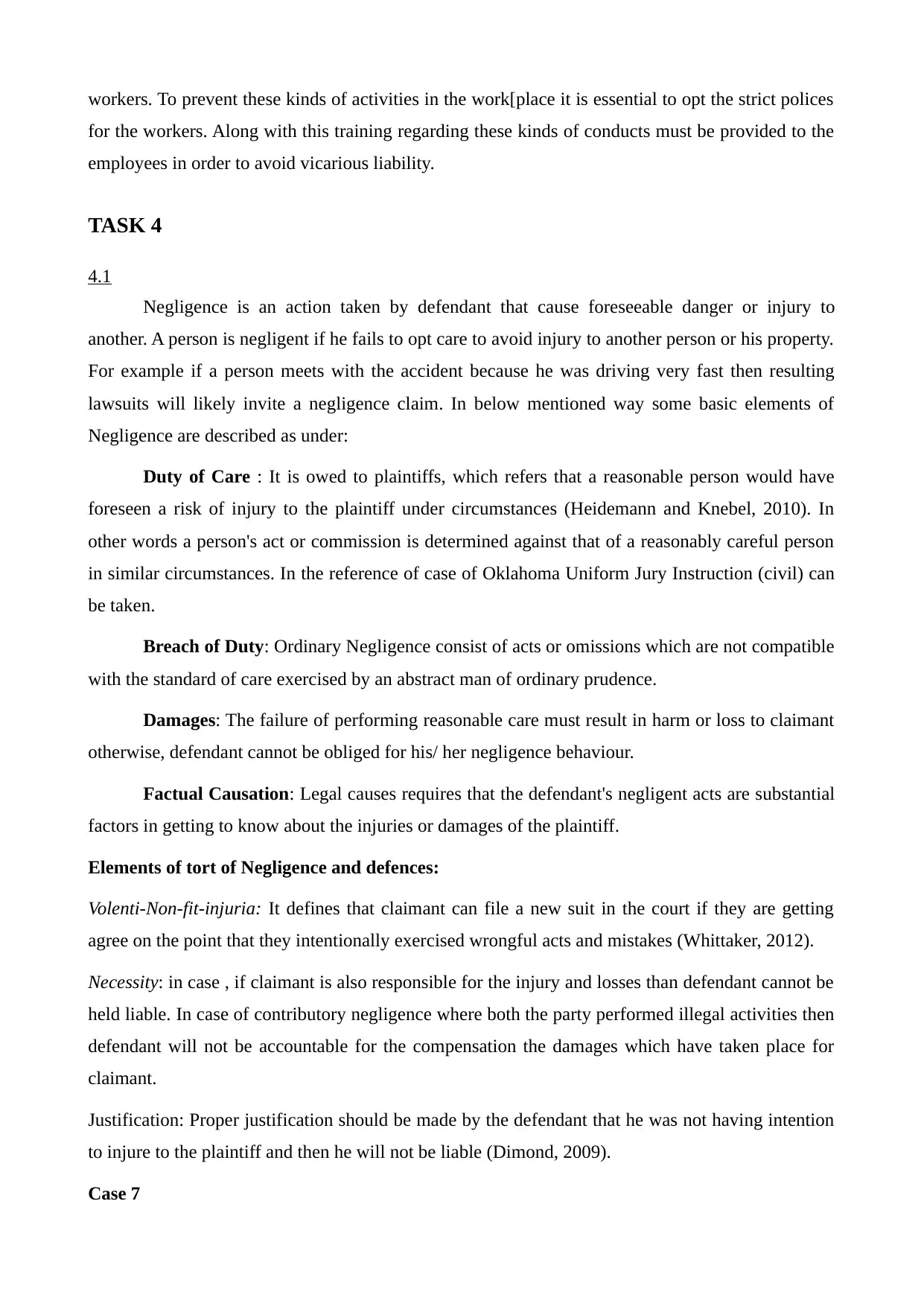
workers. To prevent these kinds of activities in the work[place it is essential to opt the strict polices
for the workers. Along with this training regarding these kinds of conducts must be provided to the
employees in order to avoid vicarious liability.
TASK 4
4.1
Negligence is an action taken by defendant that cause foreseeable danger or injury to
another. A person is negligent if he fails to opt care to avoid injury to another person or his property.
For example if a person meets with the accident because he was driving very fast then resulting
lawsuits will likely invite a negligence claim. In below mentioned way some basic elements of
Negligence are described as under:
Duty of Care : It is owed to plaintiffs, which refers that a reasonable person would have
foreseen a risk of injury to the plaintiff under circumstances (Heidemann and Knebel, 2010). In
other words a person's act or commission is determined against that of a reasonably careful person
in similar circumstances. In the reference of case of Oklahoma Uniform Jury Instruction (civil) can
be taken.
Breach of Duty: Ordinary Negligence consist of acts or omissions which are not compatible
with the standard of care exercised by an abstract man of ordinary prudence.
Damages: The failure of performing reasonable care must result in harm or loss to claimant
otherwise, defendant cannot be obliged for his/ her negligence behaviour.
Factual Causation: Legal causes requires that the defendant's negligent acts are substantial
factors in getting to know about the injuries or damages of the plaintiff.
Elements of tort of Negligence and defences:
Volenti-Non-fit-injuria: It defines that claimant can file a new suit in the court if they are getting
agree on the point that they intentionally exercised wrongful acts and mistakes (Whittaker, 2012).
Necessity: in case , if claimant is also responsible for the injury and losses than defendant cannot be
held liable. In case of contributory negligence where both the party performed illegal activities then
defendant will not be accountable for the compensation the damages which have taken place for
claimant.
Justification: Proper justification should be made by the defendant that he was not having intention
to injure to the plaintiff and then he will not be liable (Dimond, 2009).
Case 7
for the workers. Along with this training regarding these kinds of conducts must be provided to the
employees in order to avoid vicarious liability.
TASK 4
4.1
Negligence is an action taken by defendant that cause foreseeable danger or injury to
another. A person is negligent if he fails to opt care to avoid injury to another person or his property.
For example if a person meets with the accident because he was driving very fast then resulting
lawsuits will likely invite a negligence claim. In below mentioned way some basic elements of
Negligence are described as under:
Duty of Care : It is owed to plaintiffs, which refers that a reasonable person would have
foreseen a risk of injury to the plaintiff under circumstances (Heidemann and Knebel, 2010). In
other words a person's act or commission is determined against that of a reasonably careful person
in similar circumstances. In the reference of case of Oklahoma Uniform Jury Instruction (civil) can
be taken.
Breach of Duty: Ordinary Negligence consist of acts or omissions which are not compatible
with the standard of care exercised by an abstract man of ordinary prudence.
Damages: The failure of performing reasonable care must result in harm or loss to claimant
otherwise, defendant cannot be obliged for his/ her negligence behaviour.
Factual Causation: Legal causes requires that the defendant's negligent acts are substantial
factors in getting to know about the injuries or damages of the plaintiff.
Elements of tort of Negligence and defences:
Volenti-Non-fit-injuria: It defines that claimant can file a new suit in the court if they are getting
agree on the point that they intentionally exercised wrongful acts and mistakes (Whittaker, 2012).
Necessity: in case , if claimant is also responsible for the injury and losses than defendant cannot be
held liable. In case of contributory negligence where both the party performed illegal activities then
defendant will not be accountable for the compensation the damages which have taken place for
claimant.
Justification: Proper justification should be made by the defendant that he was not having intention
to injure to the plaintiff and then he will not be liable (Dimond, 2009).
Case 7
Paraphrase This Document
Need a fresh take? Get an instant paraphrase of this document with our AI Paraphraser
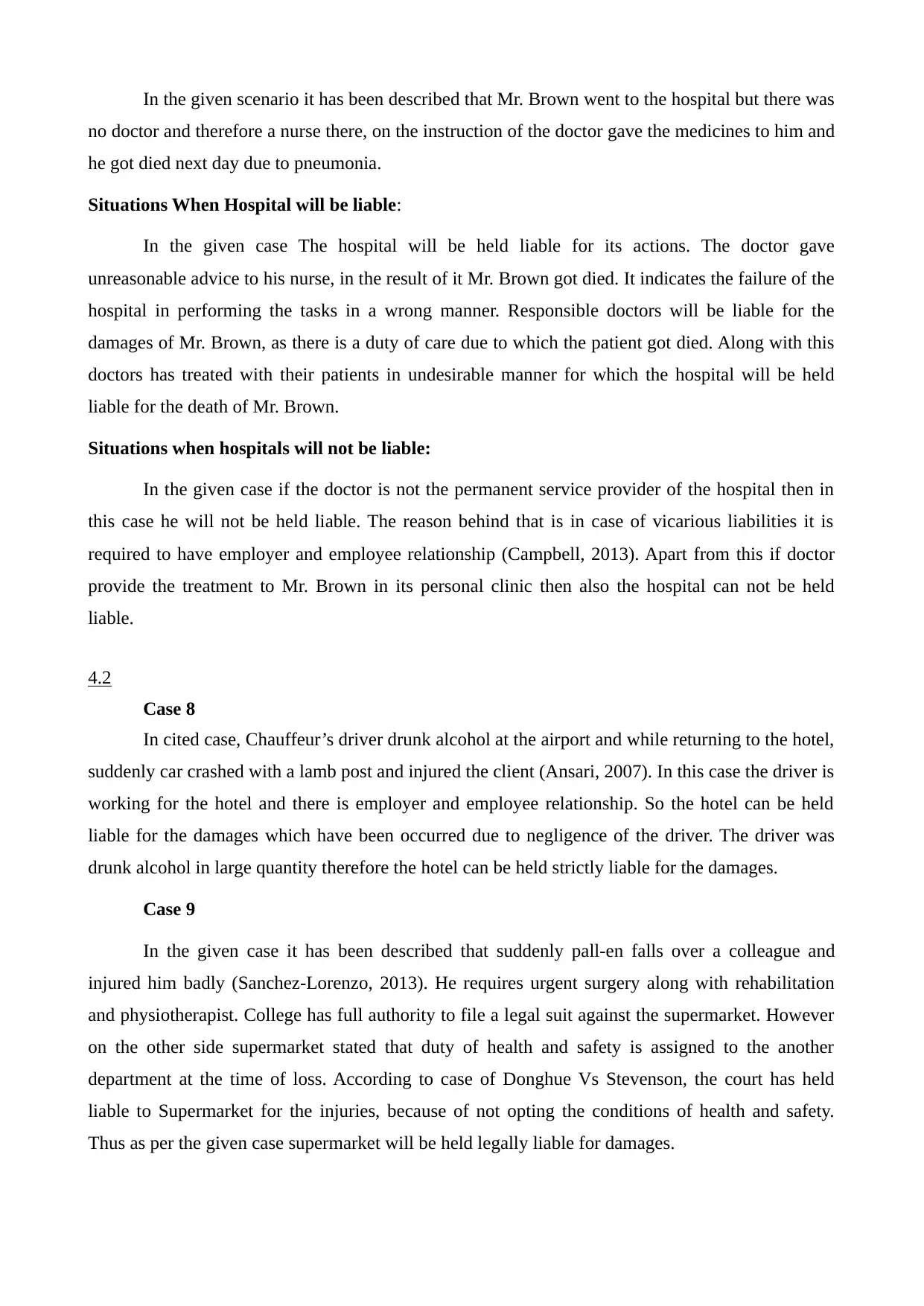
In the given scenario it has been described that Mr. Brown went to the hospital but there was
no doctor and therefore a nurse there, on the instruction of the doctor gave the medicines to him and
he got died next day due to pneumonia.
Situations When Hospital will be liable:
In the given case The hospital will be held liable for its actions. The doctor gave
unreasonable advice to his nurse, in the result of it Mr. Brown got died. It indicates the failure of the
hospital in performing the tasks in a wrong manner. Responsible doctors will be liable for the
damages of Mr. Brown, as there is a duty of care due to which the patient got died. Along with this
doctors has treated with their patients in undesirable manner for which the hospital will be held
liable for the death of Mr. Brown.
Situations when hospitals will not be liable:
In the given case if the doctor is not the permanent service provider of the hospital then in
this case he will not be held liable. The reason behind that is in case of vicarious liabilities it is
required to have employer and employee relationship (Campbell, 2013). Apart from this if doctor
provide the treatment to Mr. Brown in its personal clinic then also the hospital can not be held
liable.
4.2
Case 8
In cited case, Chauffeur’s driver drunk alcohol at the airport and while returning to the hotel,
suddenly car crashed with a lamb post and injured the client (Ansari, 2007). In this case the driver is
working for the hotel and there is employer and employee relationship. So the hotel can be held
liable for the damages which have been occurred due to negligence of the driver. The driver was
drunk alcohol in large quantity therefore the hotel can be held strictly liable for the damages.
Case 9
In the given case it has been described that suddenly pall-en falls over a colleague and
injured him badly (Sanchez-Lorenzo, 2013). He requires urgent surgery along with rehabilitation
and physiotherapist. College has full authority to file a legal suit against the supermarket. However
on the other side supermarket stated that duty of health and safety is assigned to the another
department at the time of loss. According to case of Donghue Vs Stevenson, the court has held
liable to Supermarket for the injuries, because of not opting the conditions of health and safety.
Thus as per the given case supermarket will be held legally liable for damages.
no doctor and therefore a nurse there, on the instruction of the doctor gave the medicines to him and
he got died next day due to pneumonia.
Situations When Hospital will be liable:
In the given case The hospital will be held liable for its actions. The doctor gave
unreasonable advice to his nurse, in the result of it Mr. Brown got died. It indicates the failure of the
hospital in performing the tasks in a wrong manner. Responsible doctors will be liable for the
damages of Mr. Brown, as there is a duty of care due to which the patient got died. Along with this
doctors has treated with their patients in undesirable manner for which the hospital will be held
liable for the death of Mr. Brown.
Situations when hospitals will not be liable:
In the given case if the doctor is not the permanent service provider of the hospital then in
this case he will not be held liable. The reason behind that is in case of vicarious liabilities it is
required to have employer and employee relationship (Campbell, 2013). Apart from this if doctor
provide the treatment to Mr. Brown in its personal clinic then also the hospital can not be held
liable.
4.2
Case 8
In cited case, Chauffeur’s driver drunk alcohol at the airport and while returning to the hotel,
suddenly car crashed with a lamb post and injured the client (Ansari, 2007). In this case the driver is
working for the hotel and there is employer and employee relationship. So the hotel can be held
liable for the damages which have been occurred due to negligence of the driver. The driver was
drunk alcohol in large quantity therefore the hotel can be held strictly liable for the damages.
Case 9
In the given case it has been described that suddenly pall-en falls over a colleague and
injured him badly (Sanchez-Lorenzo, 2013). He requires urgent surgery along with rehabilitation
and physiotherapist. College has full authority to file a legal suit against the supermarket. However
on the other side supermarket stated that duty of health and safety is assigned to the another
department at the time of loss. According to case of Donghue Vs Stevenson, the court has held
liable to Supermarket for the injuries, because of not opting the conditions of health and safety.
Thus as per the given case supermarket will be held legally liable for damages.

CONCLUSION
In the given report the essential elements of a valid contract are described. In the given
report it is explained that for making a valid contract a proper knowledge of the law and other legal
proceedings is very essential. It is concluded that business can be held liable for vicarious liability
and to get restrain from it, the workers are to be guided properly. So that the entity can not be held
liable for the damages which have occurred in course of employment. It is also concluded that there
are some differences and similarities between the law of tort and contractual liability. In addition to
this all the terms and conditions of the contract should be communicated to both the parties so that
the purpose of it can be obtained.
In the given report the essential elements of a valid contract are described. In the given
report it is explained that for making a valid contract a proper knowledge of the law and other legal
proceedings is very essential. It is concluded that business can be held liable for vicarious liability
and to get restrain from it, the workers are to be guided properly. So that the entity can not be held
liable for the damages which have occurred in course of employment. It is also concluded that there
are some differences and similarities between the law of tort and contractual liability. In addition to
this all the terms and conditions of the contract should be communicated to both the parties so that
the purpose of it can be obtained.
⊘ This is a preview!⊘
Do you want full access?
Subscribe today to unlock all pages.

Trusted by 1+ million students worldwide
1 out of 14
Related Documents
Your All-in-One AI-Powered Toolkit for Academic Success.
+13062052269
info@desklib.com
Available 24*7 on WhatsApp / Email
![[object Object]](/_next/static/media/star-bottom.7253800d.svg)
Unlock your academic potential
Copyright © 2020–2025 A2Z Services. All Rights Reserved. Developed and managed by ZUCOL.





